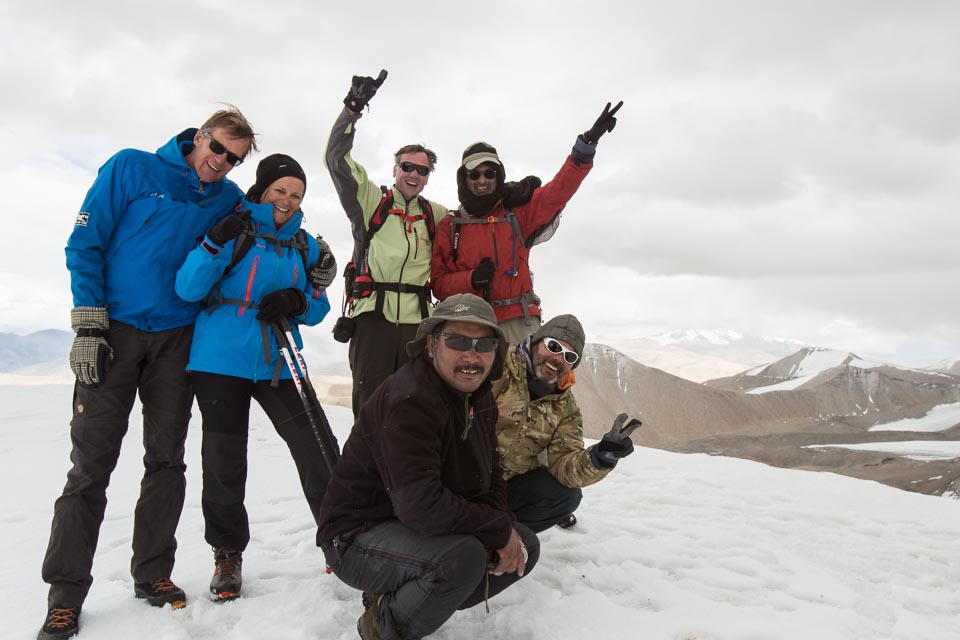6000m-6500m peaks gear discussion
Having the right gear makes climbing safer and more satisfying.
Definitions
Scrambling is just that, no climbing. We only need trekking gear, we are not climbing on snow and should only cross brief snow fields. No need for ice axe, crampons or harness.
Mountaineering is real climbing, alpine climbing, and does require ice axe, crampons (and suitable boots for them) and sometimes ropes and a harness set, depending on the mountain. Most of our climbs are on "straightforward" peaks that do NOT require a harness, which simplifies the climbing and makes for lighter loads too.
Mountaineering with a harness and rope has insurance implications you should be aware of.
6000m-6500m gear
For the most part your trek clothing will work for Ladakh's summer scrambling and mountaineering as well.
What to expect
When it is sunny with no wind then a thermal top is enough, backed up by a fleece or light down jacket for rest stops and a windproof or waterproof breathable jacket for when the wind picks up. Semi-windproof trekking pants or light softshell pants are also enough but must be backed up by a second layer that is either insulating or completely windproof.

See what everyone is wearing here at a little over 6200m on a cool, windy day (note there was snow only on the very top):
Additional gear
As extra to the trekking gear for 6000m peak climbs your should have:
+ wraparound high quality sunglasses (or with side pieces). Ski goggles are unnecessary.
+ neck gaiter (buff, locally available)
+ new liner gloves (ie thin gloves)
+ windstopper/primaloft gloves
+ windproof pants
+ tough boots suitable for crampons
+ trekking pole with basket
+ snow gaiters OR pants that cinch on your boots
+ larger day pack, 40-50 litres

First, check our recommendations for the gear needed, only some of our 6000m peaks require crampons and ice axe, not all.
Ice axe and crampons
First, check our recommendations for the gear needed, only some of our 6000m peaks require crampons and ice axe, not all.
We usually include sets for our climbs and there are also rental options in Leh. For boots that take crampons, if we are climbing a non-technical peak, we can fit crampons on most boots. However, the best boots are stiff boots that have a heel clip for crampons. These can be the old-style "plastic" boots, or your own more modern lighter mountaineering boots.
+ ice axe (non-technical is generally better)
+ crampons
+ boots that take crampons
Do discuss your boot options with Jamie directly.
Harness set
For many of the peaks we climb you don't need a harness set, check the trip page. If we might need, we rent harness sets. If you have your own, you need:
+ light harness (Black Diamond's Couloir is perfect)
+ jumar with correct length tape
+ belay device: ATC or figure of 8 etc
+ two locking carabiners, two non-locking ones
+ two prusik cords, one short, one long
Helmet
It is always sensible to climb with a helmet, but it is one more thing to carry and only use for a few hours. For the trekking peaks (eg Dzo Jongo) there is no stonefall danger and it is rare for climbers to use a helmet, but that is your decision.
Boots
See the individual trek page for our recommendations for that particular trip.
For 6000-6500m peaks in India good leather/hybrid boots that take crampons are adequate. If you have your own mountaineering boots, do bring them.
Who carries what for the climb
You carry a day pack with your personal gear including down jacket, crampons, ice axe (harness) etc, so your pack can end up quite full.
Below, on the summit of Lungser Kangri 6666m in a whiteout:

Jullay - we look forward to meeting you!


